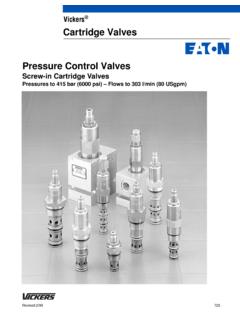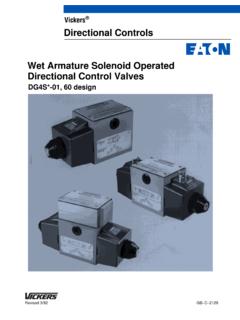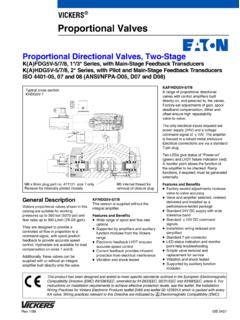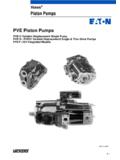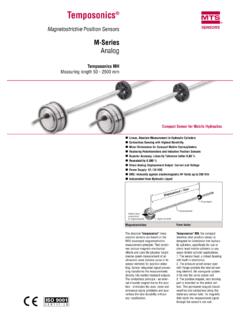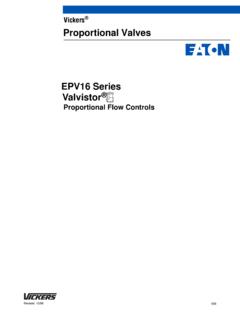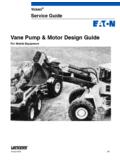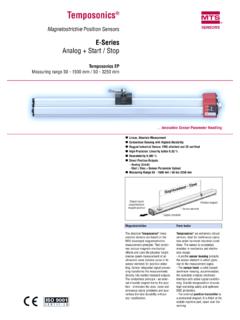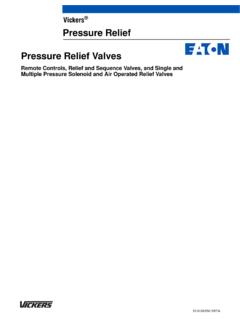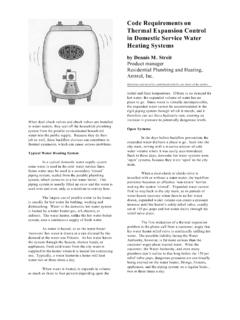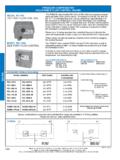Transcription of Vickers Pressure Relief - Vickers Hydraulics
1 Vickers . Pressure Relief Sequence, Unloading, Back Pressure , Counterbalance, and Reducing Valves R , UR , and X 03/06/10/12 Series Pressures to 210 bar (3000 psi) Flows to 284 l/min (75 USgpm). Released 7/94 686. Introduction R Series Sequence, overrunning. A remote P' version is also system, the valve cuts out automatically available for use in braking circuits. when the accumulator Pressure reaches Unloading, Back adjusted maximum. At cut-in Pressure Pressure , and Counterbalance (approximately 85% of adjusted maximum), the valve directs delivery to Counterbalance Valves Vickers Hydrocushion type the accumulator and the hydraulic counterbalance valves are used for the There are several configurations of this system automatically. control of unloading and sequence of oil basic valve which can be made by flow in hydraulic systems, induced by changing cover positions.
2 The following In a double pump system, the valve Pressure rise either directly or by remote outlines each type of function. automatically sequences the pumps to means. They are available in the following types: counterbalance valve, deliver a large volume of oil at low Sequence and Unloading Pressure and a small volume of oil at Type 1 internally operated;. Vickers Hydrocushion type Pressure counterbalance valve, Type 4 remotely high Pressure . control valves are used for the control of controlled. These valves are usually unloading and sequence of oil flow in applied in a system to keep a vertical Models designated URT have threaded hydraulic systems, induced by a load from falling. All models provide free ports and require a separate check Pressure rise, directly or by remote reverse flow by means of an integral valve to function as an unloading circuit.
3 Means. They are available in the check valve. (Refer to valves without following types: sequence valve, Type integral check when reverse free flow is X Series Pressure 2 directly operated; sequence valve, Type 3 remotely controlled; unloading not required.) Reducing Valves valve, Type 4 remotely controlled. These Pressure reducing valves UR Series Unloading maintain a reduced level of outlet Back Pressure Relief Valves with Pressure regardless of variations in inlet Pressure above the Pressure setting of Back Pressure valves are designated as Integral Check Module the valve. The valves also allow reverse Type 1 internally operated. They are An integral check valve prevents return free flow at pressures below the setting used to provide back Pressure on the flow from the accumulator through the of the valve.
4 hydraulic actuator to prevent unloading valve. In an accumulator Table of Contents Series R(C)*-03/06/10/12 Sequence, Unloading, Back Pressure , and Counterbalance Valves .. 3. Series URT*-06/10 Unloading Relief Valves .. 14. Series URG*-06/10 Unloading Relief Valves .. 17. Series XSL/XTL-03 Pressure Reducing Valves .. 21. Series XGL-03 Pressure Reducing Valves .. 23. Series X(C)*-03/06/10 Pressure Reducing Valves .. 26. Application Data .. 35. 2. Series R(C)*-03/06/10/12 Sequence, Unloading, Back Pressure , and Counterbalance Valves Ratings Rated Pressure (Maximum)* 210 bar (3000 psi). Rated Capacity (Maximum)**. R*-03 45 l/min (12 USgpm). R*-06 114 l/min (30 USgpm). R*-10 and R*-12 284 l/min (75 USgpm). * 140 bar (2000 psi) permitted on the full piston area at the bottom cover ( P connection), and at the top cover (spring chamber).
5 See tank drain information on page 4. ** Rated capacities are based on using fluid with a specific gravity of and a viscosity of 20 cSt (100 SUS). Model Code 1 2 3 4 5 6 7 8 9. 1 Special seals 5 Valve size 7 Remote control connection F3 For mineral oil and fire resistant 03 3/. 8 pipe or UNF-2B P Auxiliary remote Pressure fluids. Mounting face seals of straight thread ( tubing) control connection (not RCG model are standard 06 3/4 pipe or UN-2B available with X, Y, or Z. Buna-N unless specified as F3. straight thread ( tubing) Pressure ranges or in Blank Omit for standard, R(C)S, and 10 11/4 pipe or UN-2B R(C)G-03 models). R(C)T models. straight thread ( tubing) Blank Omit if not required 12 11/2 pipe or UN-2B. straight thread ( tubing). 2 Valve type (not available in R(C)G models) 8 Valve application type R Pressure control valve 1 Internal drain directly operated 2 External drain directly operated 6 Pressure range 3 External drain remotely operated 3 Integral check valve X 0,7 to 2,1 bar (10 to 30 psi) 4 Internal drain remotely operated C Reverse free flow check Y 2,1 to 4,1 bar (30 to 60 psi).
6 Z 4,1 to 8,5 bar (60 to 125 psi). A 5,2 to 17,2 bar (80 to 250 psi) 9 Design number 4 Connections B 8,5 to 35 bar (125 to 500 psi) Subject to change. Installation dimensions D 17,2 to 70 bar (250 to 1000 psi) same for designs 30 through 39. G Manifold or subplate mounting F 35 to 140 bar (475 to 2000 psi). S SAE straight thread T NPTF thread*. *Not recommended 3. Series R(C)*-03/06/10/12 Sequence, Unloading, Back Pressure , and Counterbalance Valves General Data Auxiliary Remote Pressure When the load is being accelerated, Pressure is maximum at the motor inlet Vickers hydrocushion type Pressure control P and under the large area of the brake control valves are used to control the All models (except R(C)G -03 and those valve spool, holding it in the full open sequencing, unloading, back Pressure , with an X , Y , or Z Pressure position and permitting free flow from and counterbalancing of oil flow in adjustment range in their model code) the exhaust port of the motor.
7 hydraulic systems. control is initiated by are available with an auxiliary remote a Pressure rise which can be sensed control connection. Required Pressure When the motor gets up to speed, load either internally (directly) or remotely. at the auxiliary connection is 1/16 of the Pressure still holds the brake valve open Models are available with or without normally required control Pressure for unless the load tries to run away. If this integral reverse free flow checks. the F Pressure range and 1/8 of the happens, the Pressure falls off at the motor normally required control Pressure for inlet and in the remote control Pressure Pressure Adjustment the A , B , and D Pressure ranges. passage. The spring force tends to close Pressure ranges (see model code (This applies to -22 design and up.))
8 The valve, thus increasing the back page 3) are maximum controllable, and Pressure on the motor, tending to brake it. each model selected should be well Brake Valve within the range given to afford fine A brake valve is used in the exhaust line When the directional valve is shifted to increments of adjustment. Pressure of a hydraulic motor to: 1) prevent neutral, inertia may cause the motor to setting must be at least 17 bar (250 psi) overspeeding when an overrunning load continue rotating against the brake valve. lower than the system Relief valve setting. is applied to the motor shaft; and 2) Until the motor stops turning, it will prevent excessive Pressure buildup operate as a pump, drawing fluid from Pressure can be adjusted by loosening when decelerating or stopping a load.
9 The motor outlet through the directional a jam nut and turning an adjustment valve and circulating it back to the motor screw. Turning clockwise increases When the RC valve is used as a brake inlet. Motor leakage oil will be made up Pressure , and turning counterclockwise valve, it has a solid spool (no drain hole by drawing oil into the loop through the decreases Pressure . through the center), and there is a tank port of the valve. At this time, remote operating Pressure connection in Pressure at the motor outlet tending to Installation Data the bottom cover directly under the spool. bring it to a stop will be whatever is Mounting This connection is teed into the supply required under the small piston to Because all R(C)T and R(C)S models line to the motor.
10 The internal control overcome the brake valve setting. have optional Pressure inlets connected connection is also used under the small by a through passage, the valves may be piston and senses Pressure from the mounted in-line . The valves may also be primary port of the RC valve, which is teed to a line by using either one of the connected to the motor exhaust port. Pressure inlets and plugging the other. The remote Pressure control connection Typical Application: Brake Valve on type 3 and 4 valves must be connected to an external pilot Pressure a A B b source sufficient to operate the valve at the desired Pressure setting and flow P T. conditions. Tank Drain The discharge outlet of valve types 1 and 4 must be piped to tank at atmospheric Pressure .
